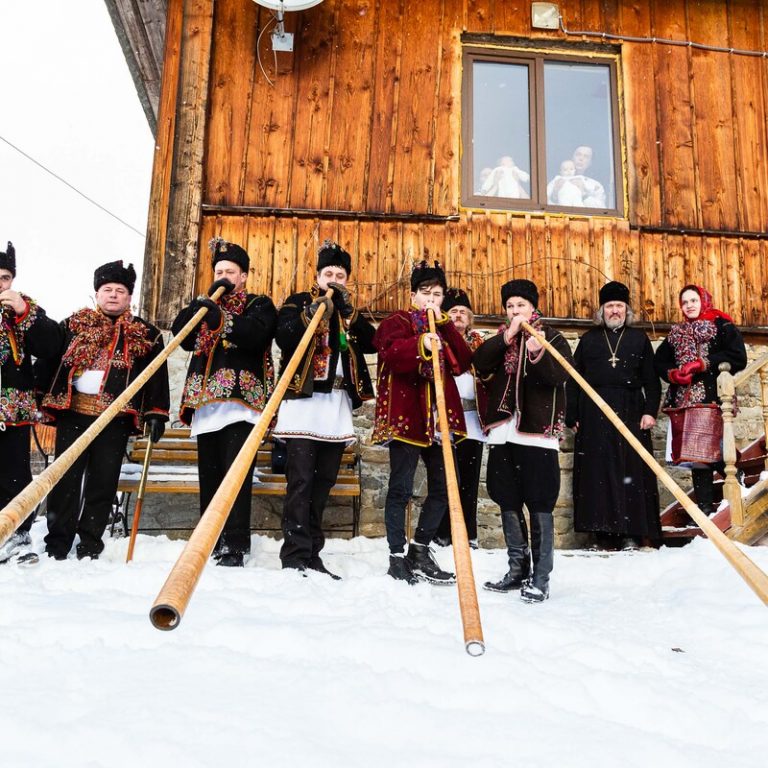“On Sunday morning, an early sunrise brought joy and glory to cherry gardens” — these lines begin a carol which has been heard in the village of Kryvorivnia in the Hutsul region for over 100 years. The tradition of Koliada (carolling — tr.) has been a part of the winter holidays since the pre-Christian times, and it has continued until today, uninterrupted. Neither adoption of Christianity nor the Soviet bans could break this lasting tradition: the singing of men and the ritual of Koliada in this village in the heart of the Carpathian Mountains.
In the old times, the carollers represented the spirits of the ancestors. Back then, Koliada was a celebration of the birth of the sun. Later, the archaic and the Christian culture intertwined, and Koliada turned from pagan to Christian, which means the birth of the sun and the birth of baby Jesus merged. Then, the priests started composing new carols together with the Hutsuls. Koliada is considered to reproduce the model of the church: it even starts in the churchyard. The carollers made it possible for the church to visit every single house: not only those in the valley by the river, but also the ones scattered high in the mountains.
Koliada is also the time for getting together and communicating, sharing thoughts and worries, especially for those who can’t meet each other often during wintertime.

Father Ivan
Besides the carollers themselves, Father Ivan Rybaruk, the local priest, cherishes the rite. At Christmas, he blesses the carollers. Then, he is in charge of distributing the money collected while carolling: for the renovation of the church, for the needs of the Armed Forces of Ukraine in the military action in the east of the country, and for people who need medical treatment.
— We don’t merely sing the carols from the past, from 100 years ago, but we also sing about the present. Carols represent what we’re living in, and that’s why they were preserved.

Father says he wishes every village in the Hutsul region would be like Kryvorivnia, where each hamlet or part of the village has its own company of carollers:
— There are villages where half of all people go carolling, there are villages where a quarter do, in some villages only a tiny portion do. But it is only us who have the whole village involved in Koliada.
Kryvorivnia has nine hamlets and thus nine companies of carollers. Now, in a time of war, one party always goes caroling to the east of the country, to the soldiers.
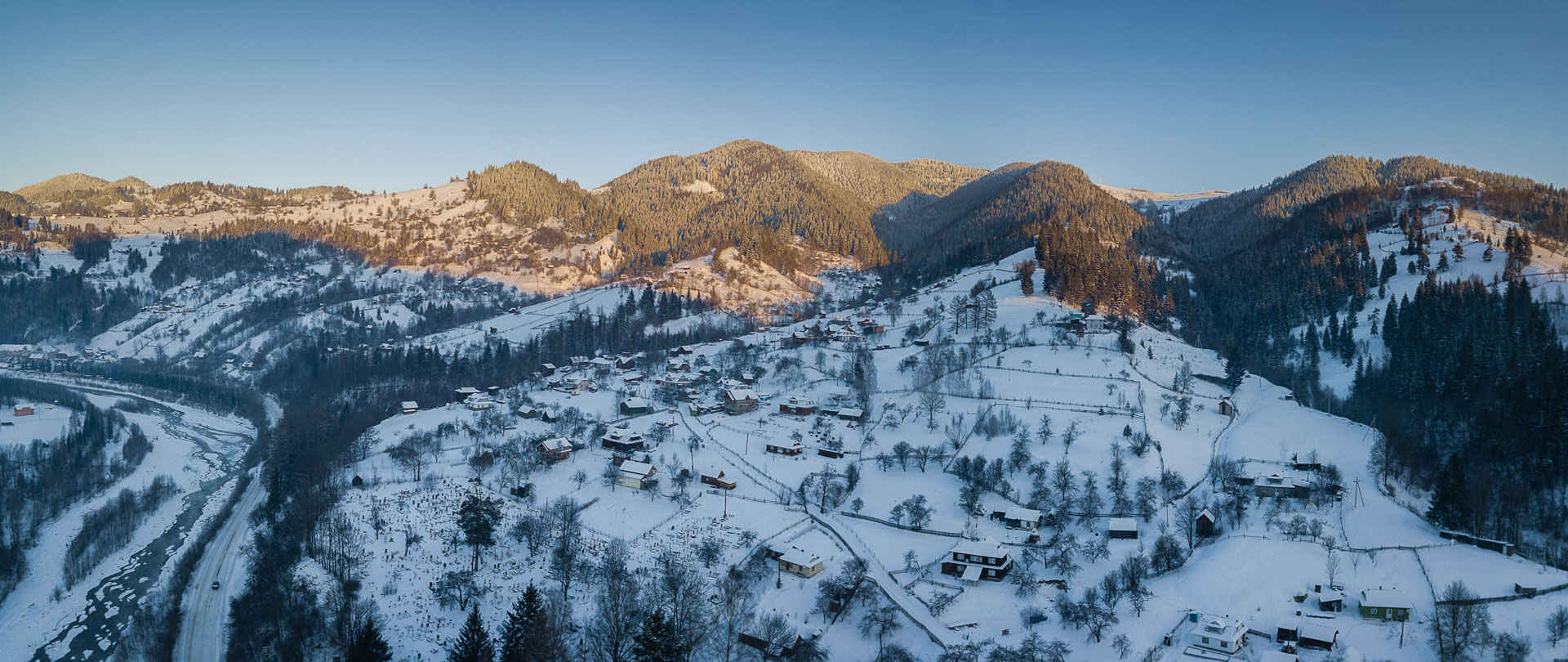
Kryvorivnia is considered both the summer and the winter capital of the Hutsul region. Ivan Franko, a Ukrainian writer, and Mykhailo Hrushevskyi, a Ukrainian academician and political leader, came to Kryvorivnia for their holidays. Here Serhii Paradzhanov shot his legendary film Shadows of Forgotten Ancestors. Many creative people always came here, and this exchange affected the place by turning it into a cultural heart throbbing with energy. To add beauty in their life, Hutsuls often use decorations with no practical purpose in their woodcarving or clothes. Ivan Rybaruk explains:
— Living in the mountains, amid this beauty we have, we can’t be different. Besides, we (Hutsuls — ed.) love freedom, we never gave up to foreign cultures or foreign authorities, but we simply lived our own life. And this desire to live our own life has let us stay the way we are. Having time to meditate, people come to understanding what’s true.
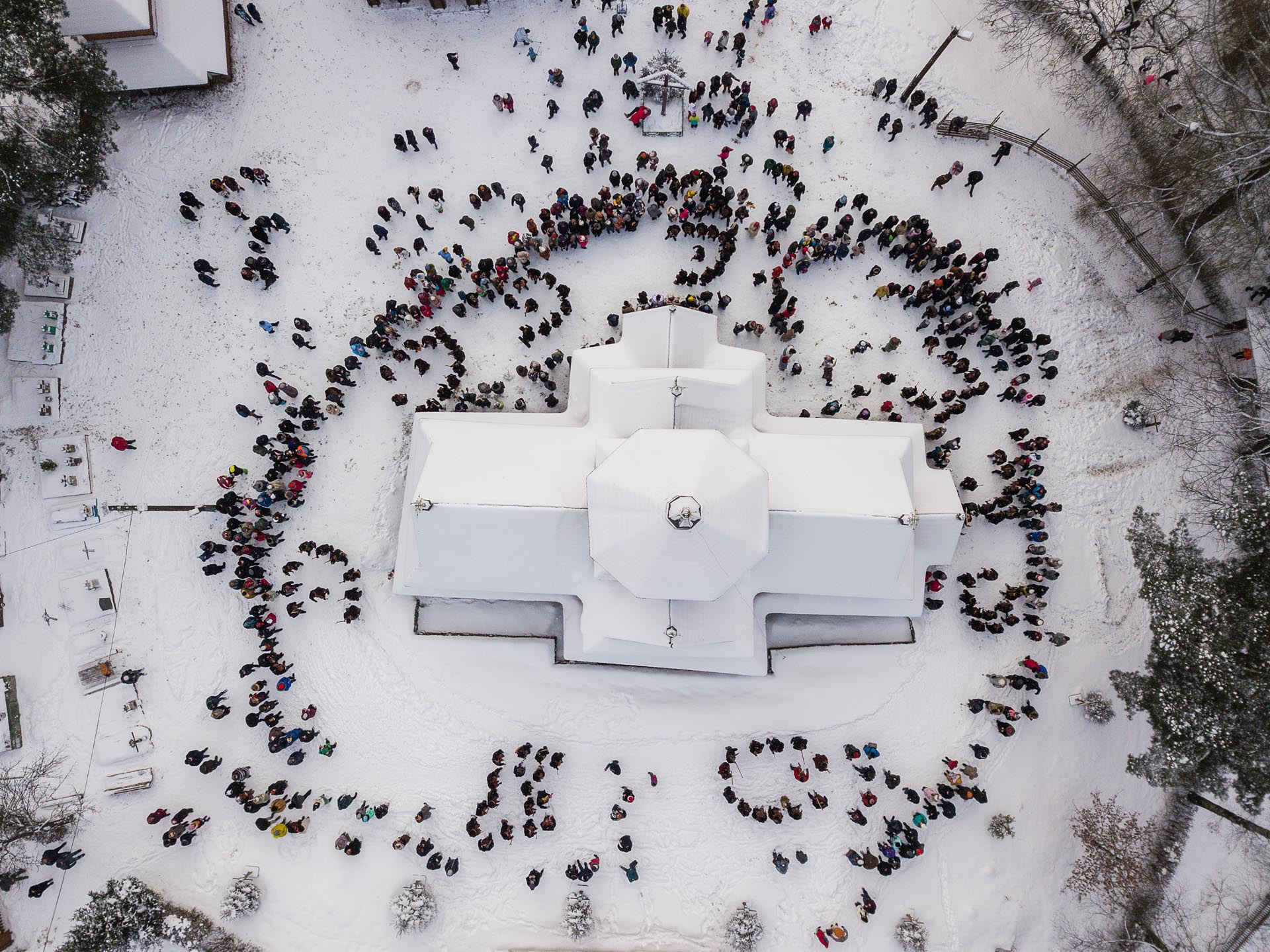
Koliada
At Christmas, the carollers gather in the churchyard. The trembita players prepare their instruments (trembita is similar to alpine horn — tr.), which lay idle for a while, by moistening them with horilka (a Ukrainian strong spirit — tr.). Meanwhile the other carollers and the guests attend the holy service and receive the sacrament of confirmation in the church. After the service, the company of carollers, the villagers, and their guests go out to the churchyard. The carollers stand round in a circle, a universal symbol of the sun, and the ‘bereza’ men (leaders of the companies of carollers — ed.) and fiddlers line up in the middle. And then starts the rite awaited for a whole year:
On Sunday morning, an early sunrise
Brought joy and glory to cherry gardens.
The cherry blossom tender and white,
Oh, little Jesus was born tonight.
Bartky (bartka is a sharp thin shepherd’s axe — ed.) rise in the air as if to beat the rhythm; horns and trembitas blow; bright colours and feathers on krysani (krysania is a Hutsul hat — ed.) gleam in the winter sun — a colourful carolling wave.
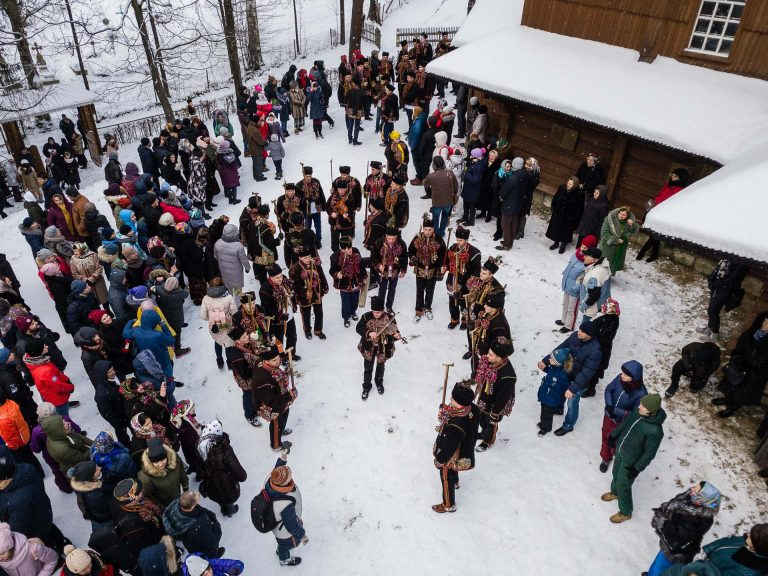
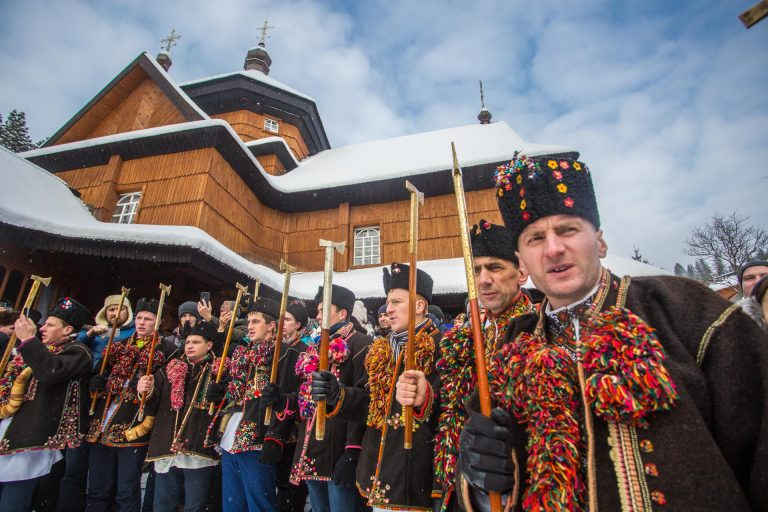
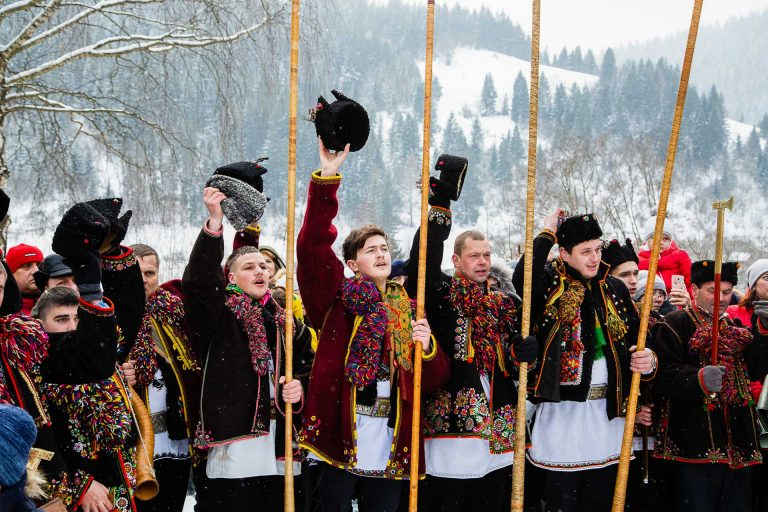
slideshow
They start a carol with plyes (a dialect word for a kind of a dance — tr.), when the carollers not only sing, but also do a little dance. Plyes has been a vital part of carolling since the pagan times. It is a kind of a winter ritual dance. The carollers dance around the church, and then — near the houses, thus bringing the joy of Christmas to the houses and the people living there. In Kryvorivnia, the carollers make their dance in one spot without moving around much, while, for example, in the village of Dzembronia, which lies nearby, they walk like a military unit.
While the carollers are doing the plyes near the house, the gazda (the owner of the house — ed.) makes up his mind whether he should invite the carollers inside or not. Once they have come in, they can sing carols for four hours or even longer.
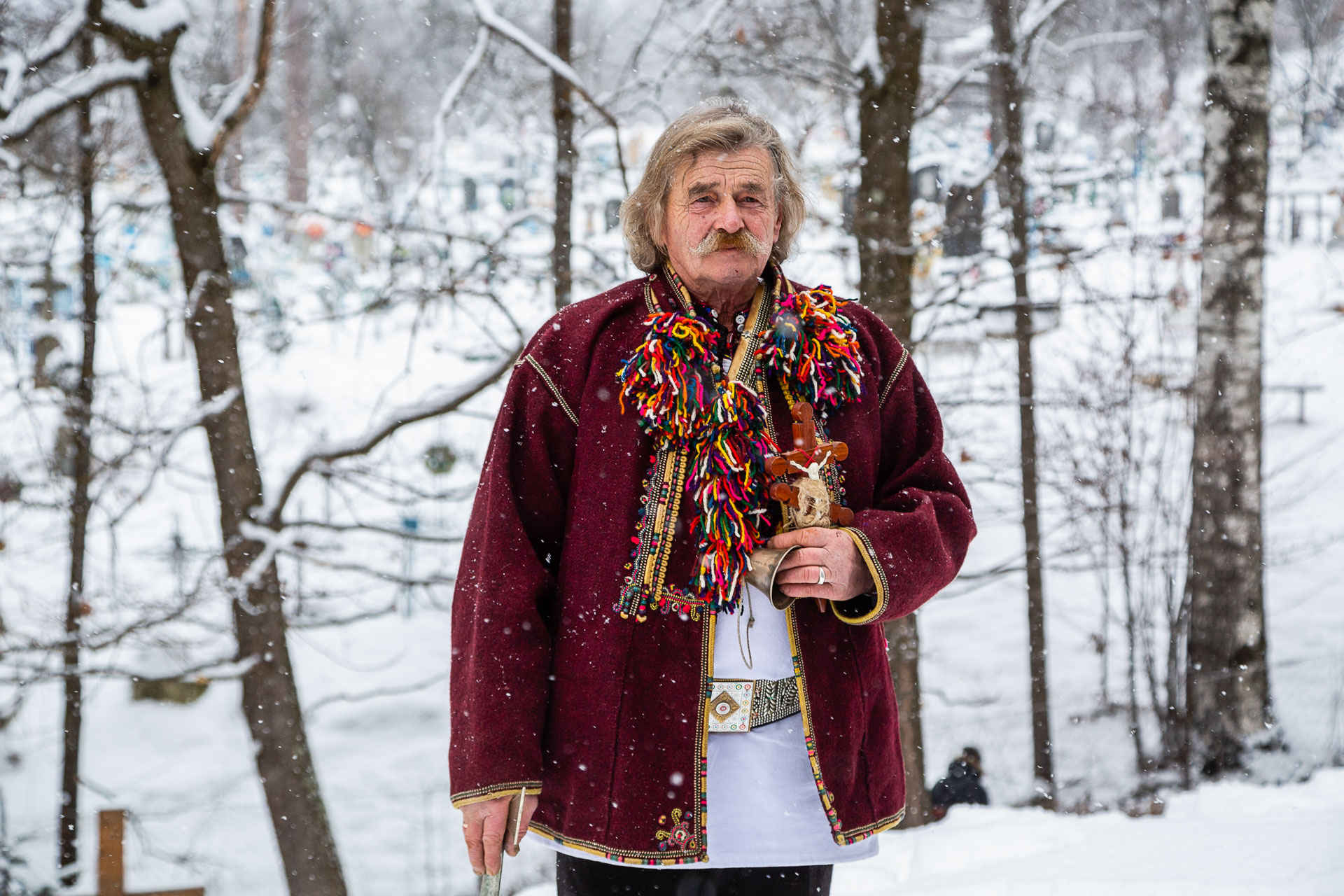
“Bereza”
In Kryvorivnia, each company of carollers must have a leader (“bereza”), a fiddler, and a trembita player. They sing a carol as they walk around the church three times, thus creating a special Hutsul carolling symphony. Then, they kneel before the priest who blesses them for Koliada, and they, in their turn, promise to visit each house and behave.
Ivan Zelenchuk has been a bereza for over thirty years in a row, following in his father’s footsteps:
— Father Ivan Rybaruk blesses us: he sprinkles us with holy water and blesses us for a peaceful Koliada. After that, you feel what’s happening in your heart, it comes like a wave, you’re no longer like the others. We are like the apostles: we go and announce that Jesus Christ was born.
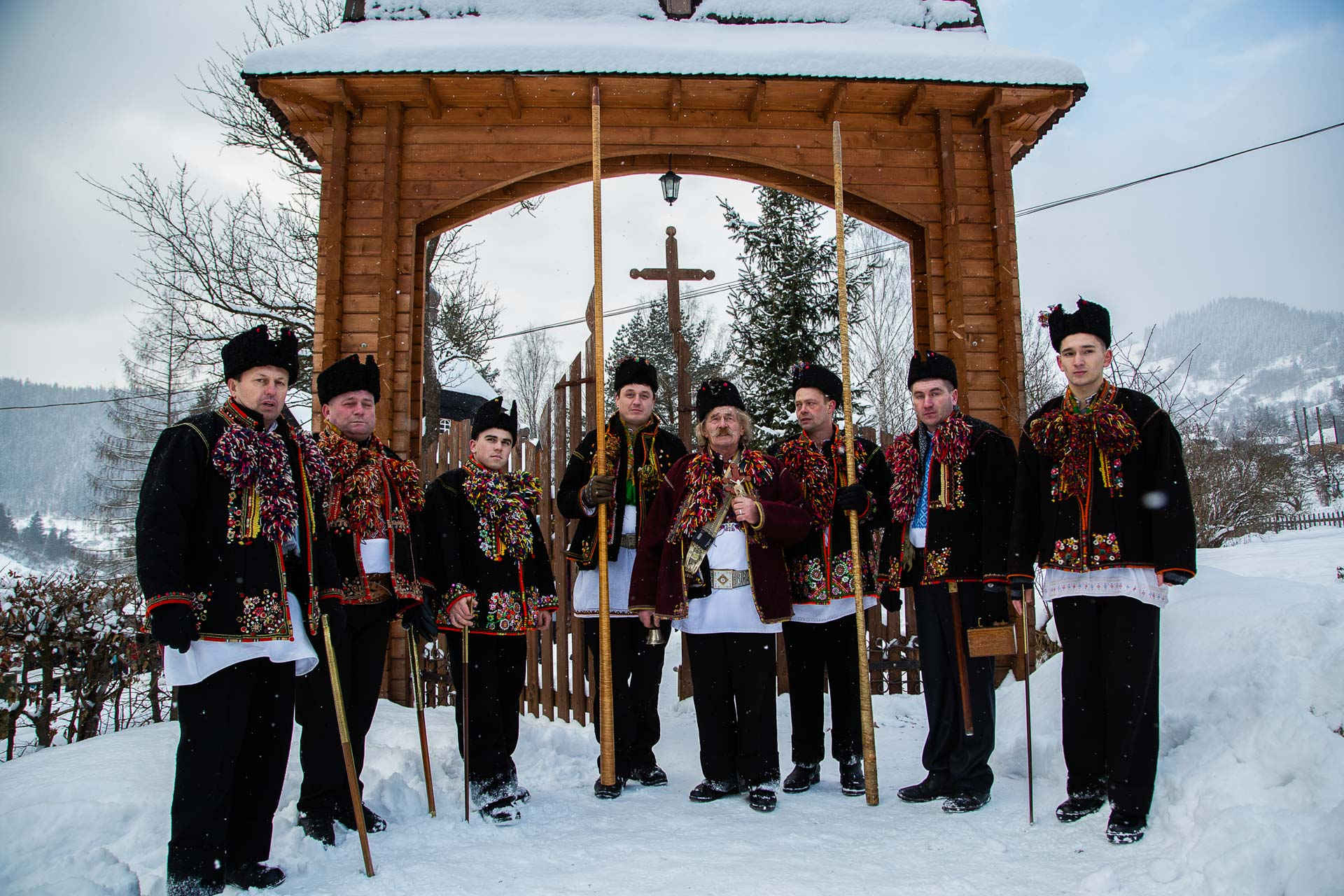
Bereza plays the role of a priest as he keeps the cross, which people kiss and which they give povismo for (povismo is flax fibre ready for spinning — tr.). In Kryvorivnia, they believe that povismo is the noblest thing which can be given for the church and its needs. However, nowadays they also give money. According to the Hutsul tradition, you should give something material to the carollers.
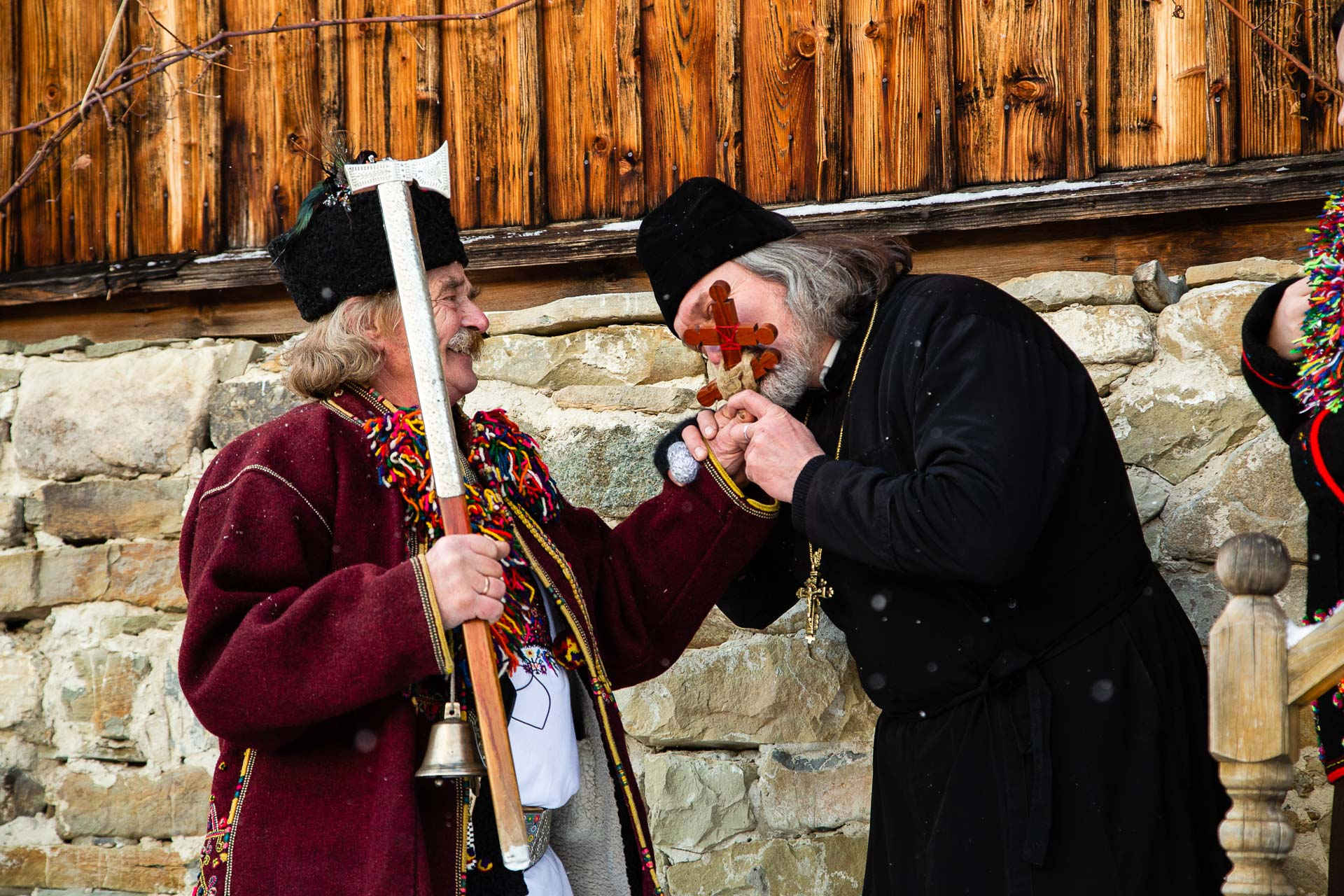
Ivan Zelenchuk says he even visited the USA a few times to present the Hutsul Koliada there:
— We were preparing for our first carolling tour: we met during a whole month, had rehearsals. My late father was bereza too, he went carolling too. My brother also goes carolling, he is bereza too. It’s like we have such a dynasty, Koliada-loving, and somehow that passes from generation to generation.
Bereza Ivan and his company, as well as all the others, start carolling on Christmas Day. It’s important to consider time and the number of houses, so that they can visit each house before the Epiphany. Koliada continues for around two weeks, and the men will be out of home during this time.
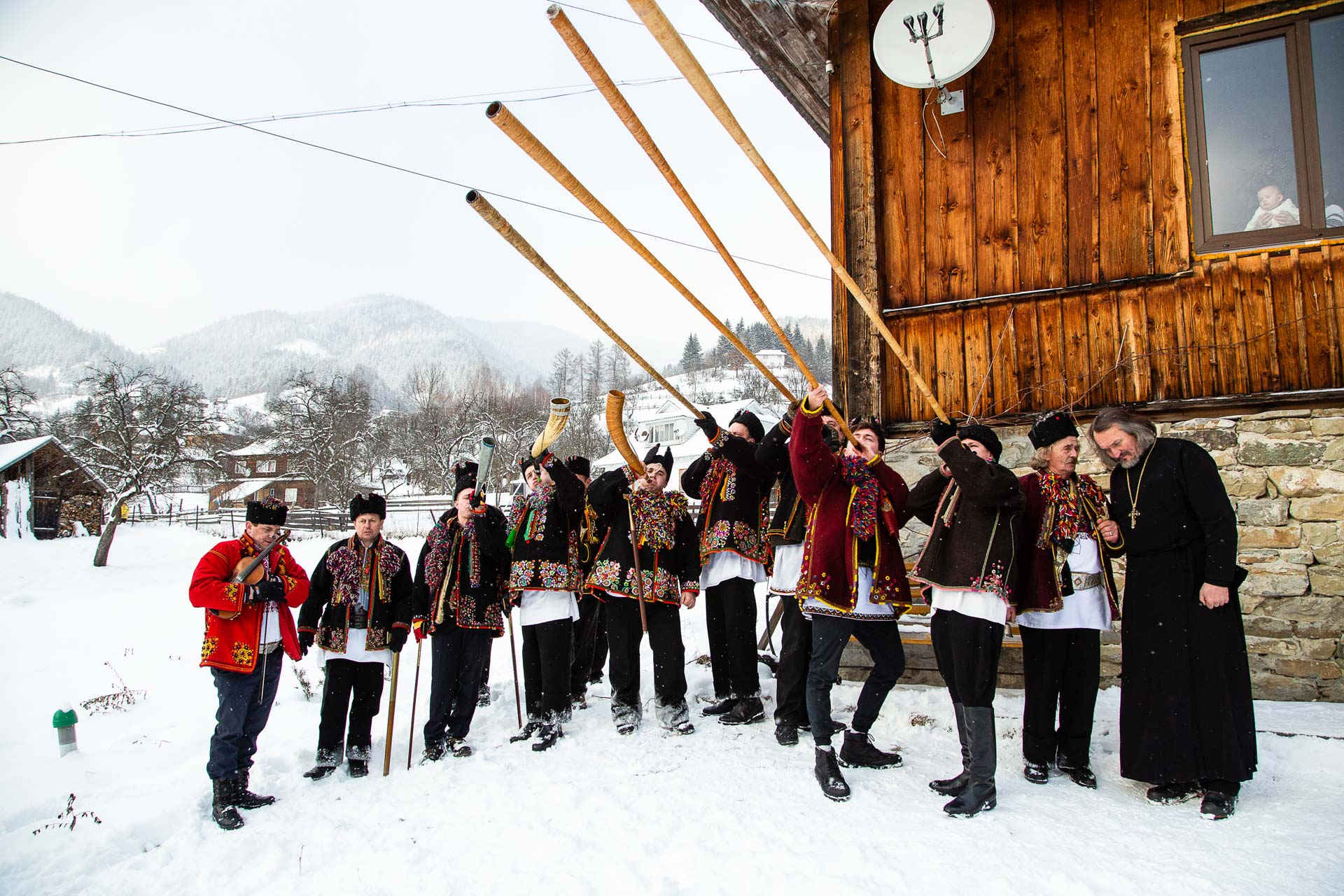
Traditionally, Hutsul women don’t go carolling with a company of men and don’t gather in companies themselves. This is a derivative of the traditional household organisation where women were supposed to take care of the children and the domestic animals, while men have always had more physical strength for survival. Still, according to Father Ivan, there were cases when women went carolling. It happened in Kryvorivnia, in Yaseniv, where once the men had a fight among themselves. Then, the women fed the children, milked the cows, and went carolling:
— But the times have changed. We may have forgotten the words that Paul the Apostle said to us: for Jesus Christ there’s no man and no woman, but everything is Christ and Christ is in everything. So, I don’t think that women are banned from carolling, but they have so much work that it would be too much.
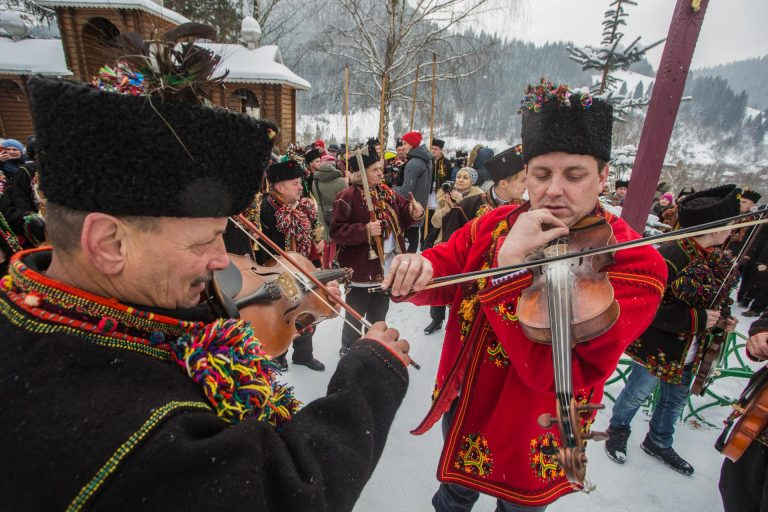
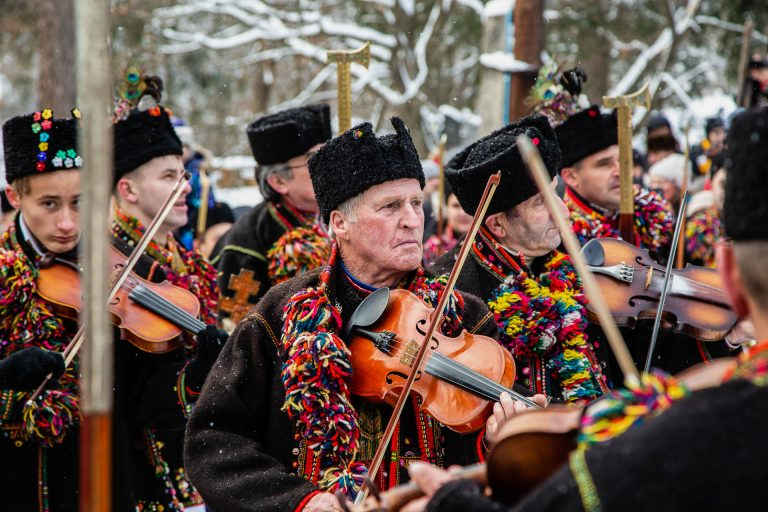
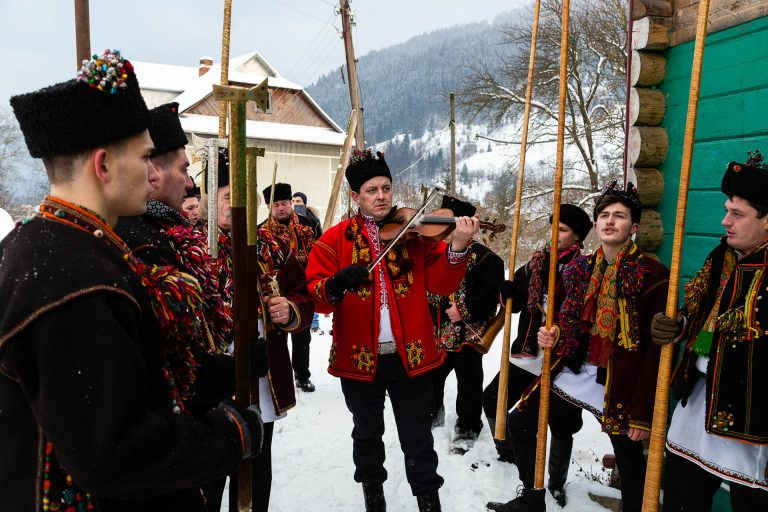
slideshow
In the past, only adult men could go carolling. Even now, not anybody is accepted in the company of carollers. Still, now the youth join the carolling companies increasingly often as they are taking on the tradition. Bereza Ivan Zelenchuk explains:
— Only a decent man can be a caroller. Troublesome men or men who like to consume too much satan (alcohol — ed.) are unwanted in the company. Well, it’s not forbidden to drink a bit, but only in moderation. Indeed, it’s that way because you mustn’t forget that you feel some sort of responsibility, that you become a bit different from what you are in your everyday life, that you have been blessed, sprinkled with holy water, and thus you must fulfil your mission with a clear conscience.
If a boy or a man skips Koliada for no serious reason, he can be expelled from the company.
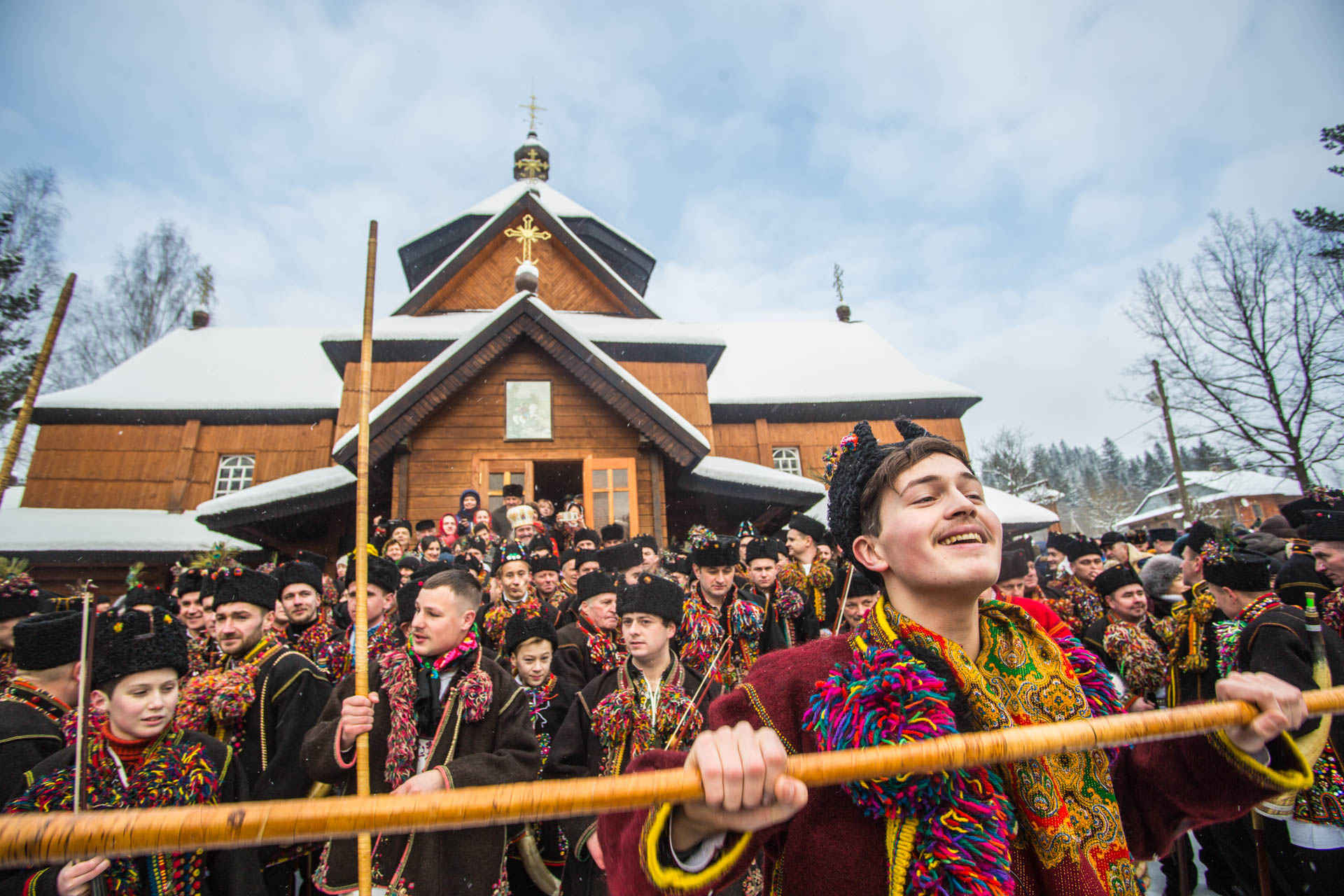
Pavlo Rybaruk, the priest’s son, joined the carolling company of Ivan Zelenchuk. He’s been carolling since he was twelve, that means for eight years already. He remembers borrowing a notebook with carols from a more experienced caroller because he wanted to copy the carols and learn to sing them. At first, he was just curious to explore and partake in Koliada due to its social function as a part of the community’s life.
For each of the carolers, it is important not only to sing, but also to understand the idea of this holiday. On the one hand, you’re singing the lyrics of the songs and communicate with the families, but on the other hand, you are holding a special holy service. Here’s how Pavlo Rybaruk describes his experience:
— That’s a moving people’s church on the wheels. I partake in this in order to read what’s written on my navel-string, to understand myself and understand the language written on my navel-string. And it helps because that’s a trip to myself through singing which is vital.
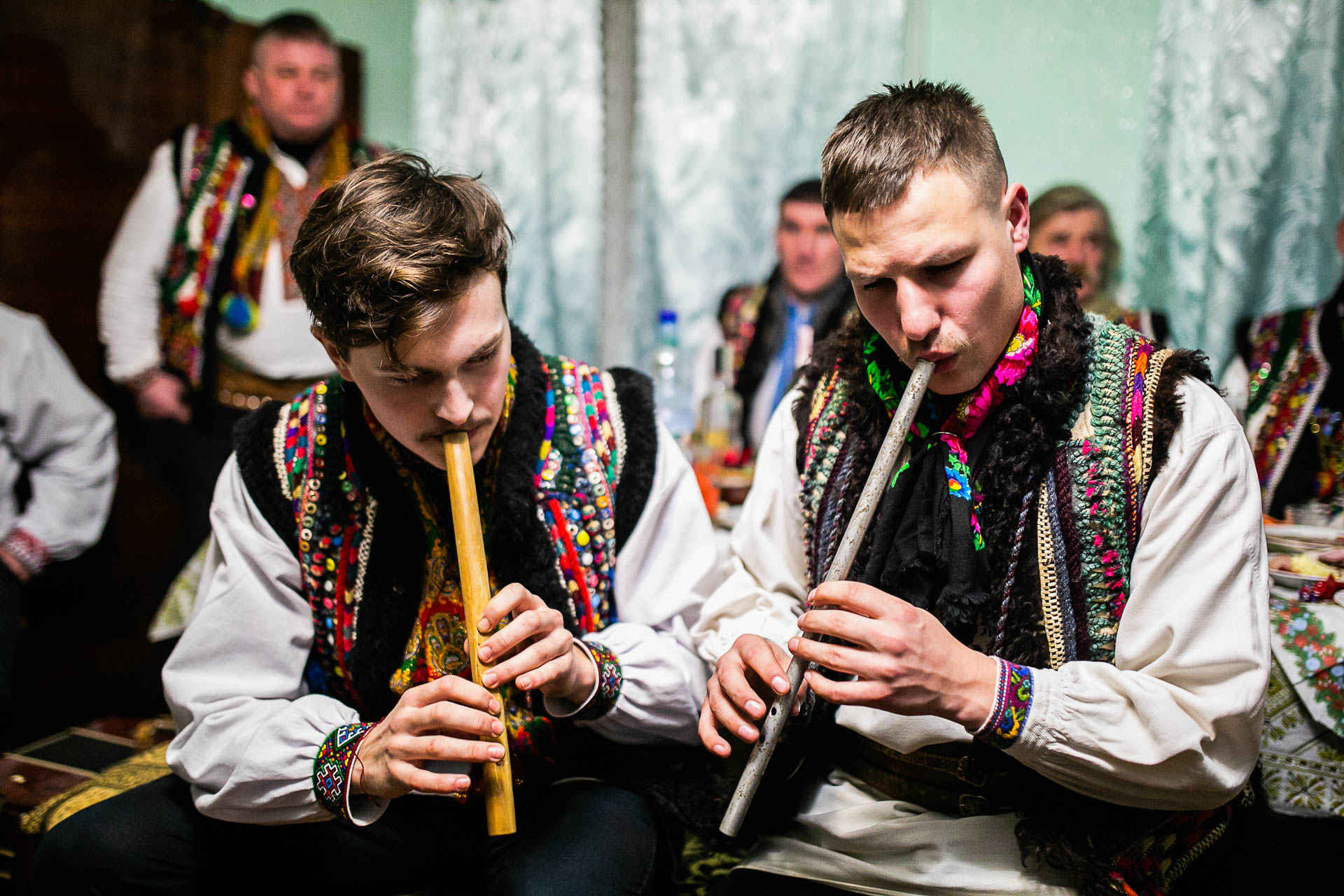
For the young man, this tradition is special because it’s associated with worshipping the sun which has been reborn in the Christian form. And this new form hasn’t deprived Koliada of the special effect where at some point you just fly away in your thoughts somewhere deep where no words exist:
— At the fifteenth minute of a carol (which lasts half an hour), you can realise you are not here, but it’s only your mouth singing songs with ten men whom you’ve been carolling with for seven years in a row in this house.
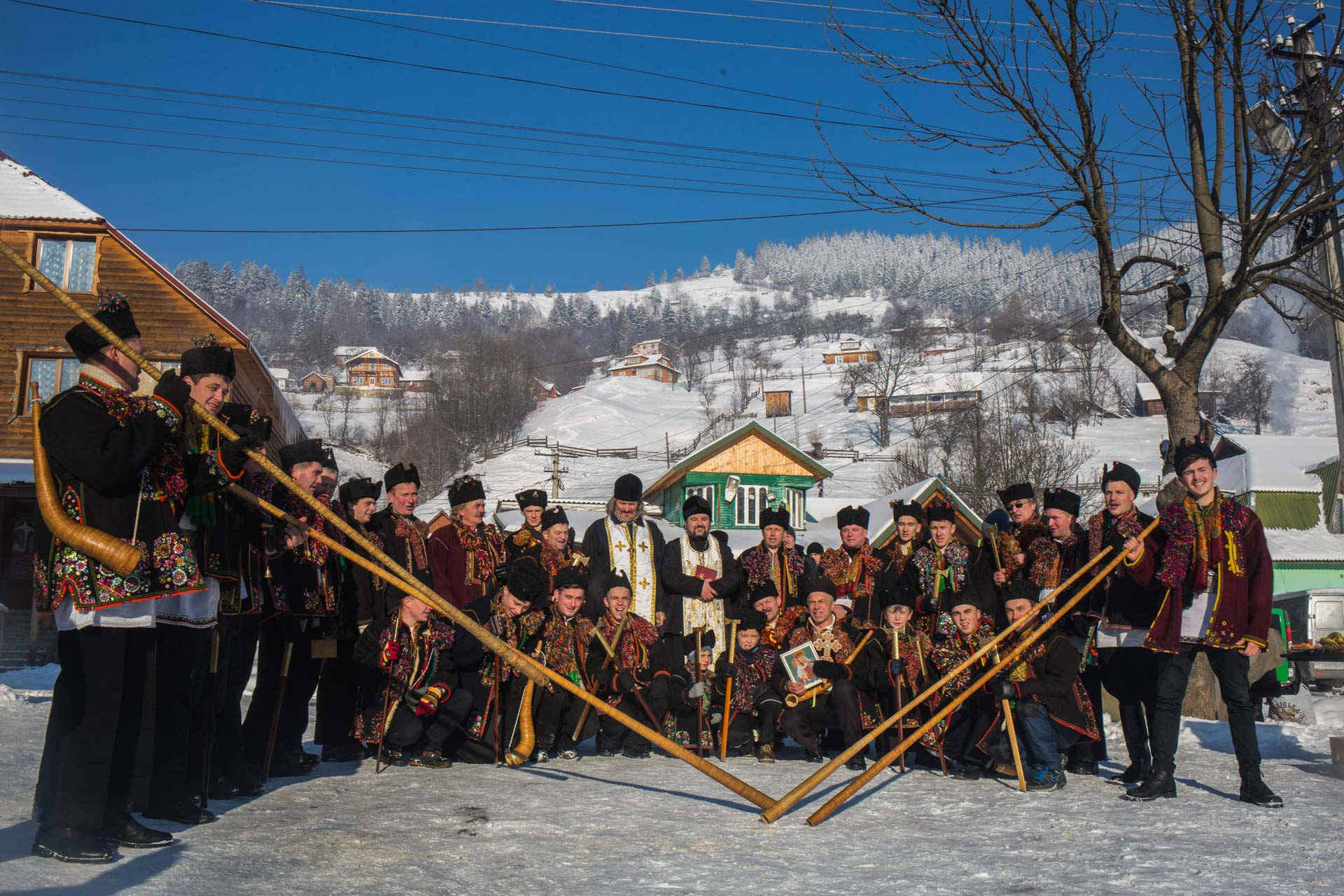
What the carolers sing about
Ivan Zelenchuk, a local researcher and ethnographer, considers the traditions of Christmas and Koliada to be syncretic as they combine pagan and Christian beliefs:
— There were carols singing that the sun was born, but that also meant that Jesus Christ was born. I believe that Koliada went on a whole new level when the two concepts were combined.
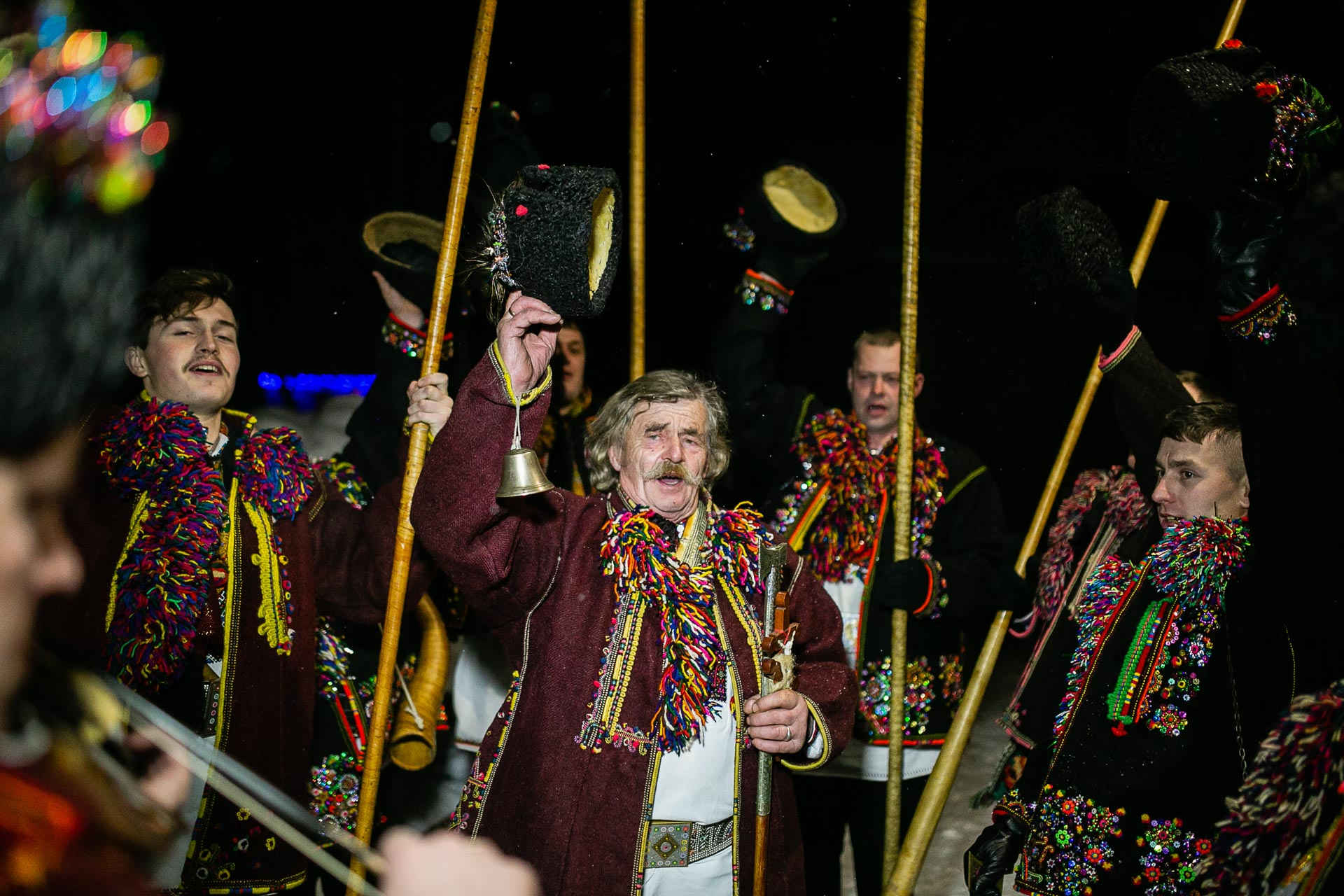
For example, among the carols, the longest one is sung by bereza for the house owners. And it has the following words:
The rooster is cut and salted
And the fish is boiled and salted,
And this rooster whose head was cut off,
And this fish, cut and salted, and boiled.
When the rooster crows without his head,
And this cut, boiled, and salted fish will jump in the water and swim away,
That’s when Jesus Christ will resurrect.
I mean that’s a very interesting form when the resurrection of Jesus Christ is correlated with resurrection in nature.
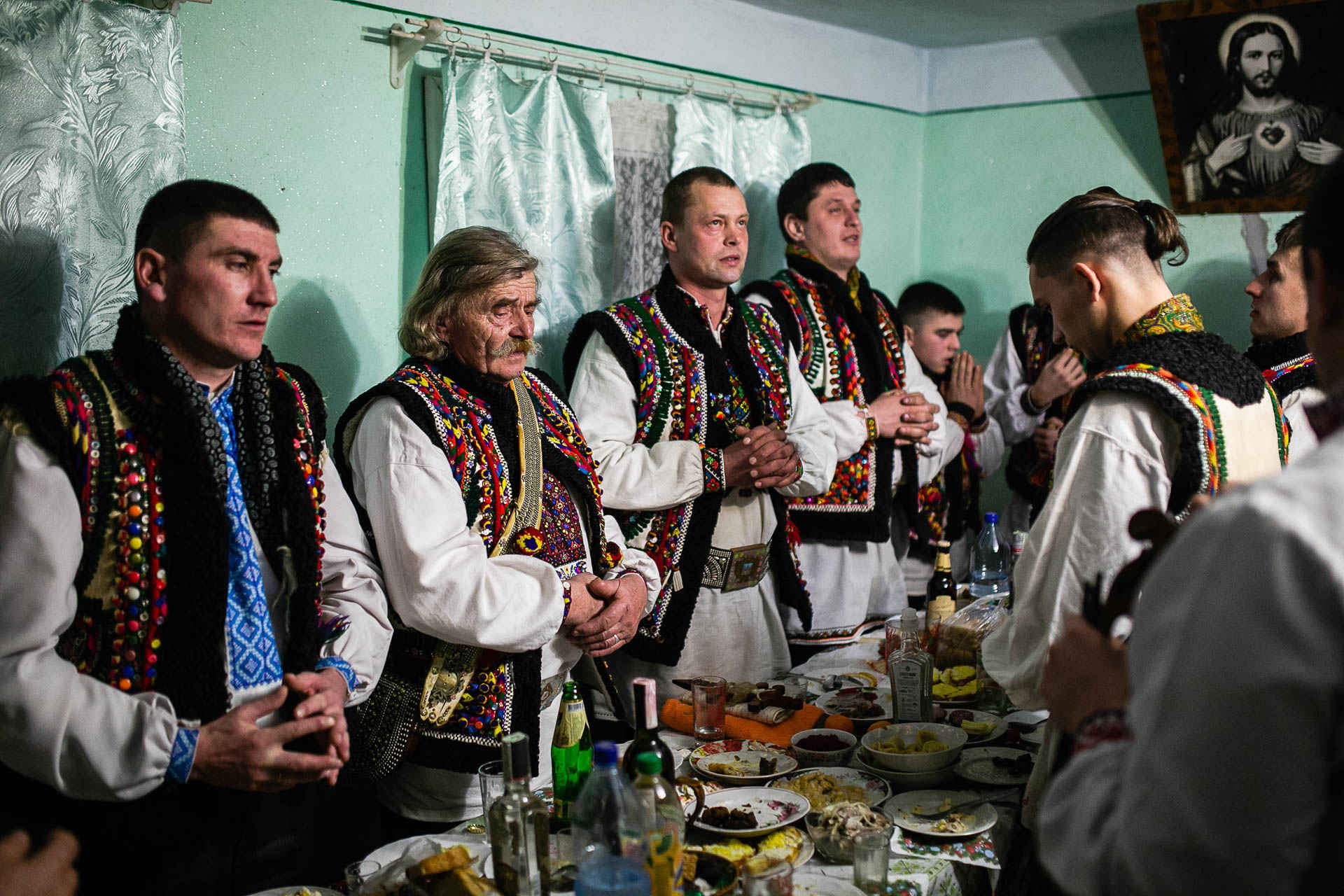
The caroler Pavlo Rybaruk also compares carols to the old Scandinavian ballads or Hindu chants. “Oh sida, da y na rida, da y na dana” — that’s a refrain often repeated in many carols and songs. Pavlo assumes it refers to the three Dakini goddesses Sida, Rida, and Danaia:
— We take everything for granted, but the roots are so deep, and those who were writing and composing those words wanted them to be sacred.
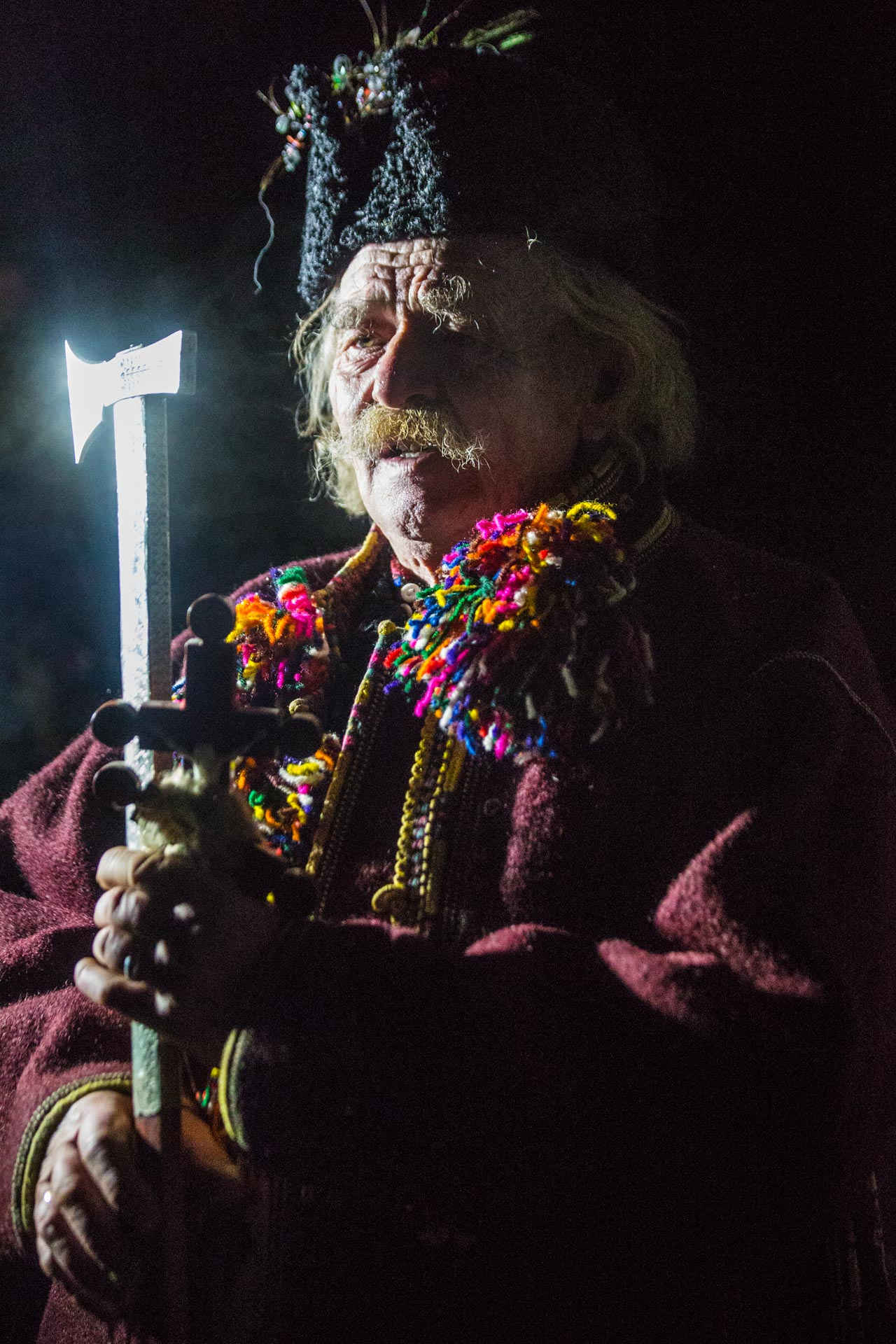
They carol differently in each house. It all depends on the hosts’ wishes. They may carol for the whole family together or for each member of the family personally, even for each child and animal. The carols are even called that way: “Koliada for the house owner”, “Koliada for a girl”, “Koliada for a boy”. The lyrics of the carols differ in each village, and even companies of carollers from the same village can sing a carol in a different manner.
It’s said that in the past, they used to dance more with the house owners in the house. Now, there’s only one dance with the house owner. It’s called “kruhliek”. It’s danced in a circle, and if the house owner has bee hives, they carol a special song for the bees.
When the carolers come to an abandoned house where nobody lives, they will still carol there so that the life comes back to that house. Once the carolers with bereza Ivan came to a house where an old lady lived. She gave them very little for their Koliada, only 10 uah. And they gave her 200 uah as a donation from them. Because it happens that Koliada doesn’t take more than a person can afford, but takes only what a person can give. And the carollers themselves help people in need.
There’s also “Umerla Koliada” (Dead Koliada — tr.). After Koliada that lasted for a few hours around the table of treats, the men stand up and sing a carol to all the dead of this house. According to the tradition, they put white bread and three candles, and the carollers ring the bells.
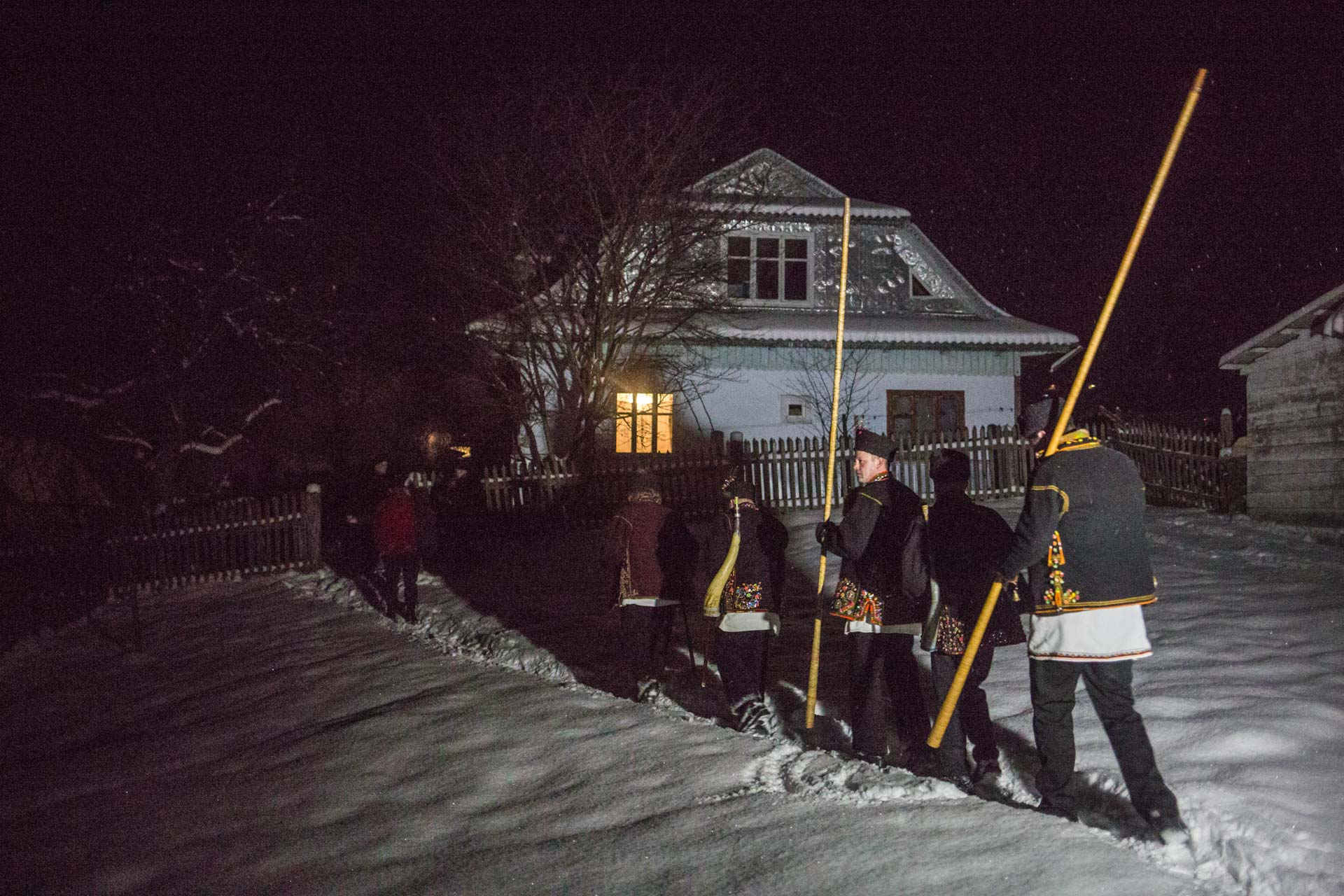
Bans of Koliada
Being an observance associated with religion, Koliada was banned twice. First, it was called a pagan ritual when Christianity became active in the Hutsul region. A writer Stanisław Vincenz writes about it in his book “On the high polonyna” (polonyna is a meadow in the Carpathians — tr.) as he speaks about the year 1830.
“We’re glorifying the birth of the sun, but we can equally be glorifying the birth of Jesus Christ, — says ethnographer Ivan Zelenchuk as he’s leafing through this book. Petro Shekeryk-Donykiv, a local writer, already calls Koliada a mobile church at around the same period, and the new carols were being written by the priests together with Hutsuls.”
In the Soviet times, church was banned, and Koliada was banned along with it. For this reason, Hutsuls went carolling secretly. Ivan Zelenchuk speaks about how they went carolling in the heights so that nobody could see them because it was considered a bad deed. In cities, the lyrics of carols could be copied with the name of Jesus replaced with Lenin because the KGB (the main security agency for the Soviet Union — tr.) could persecute the carolers.
Each Hutsul village has two parts. The bottom, where typically half of the village’s population lives, that’s in the valley on the river banks. And the other part of the village in the mountains is called ‘the heights’. The houses are scattered with the distance of around a kilometre between each other so that it’s convenient to do animal farming. In those times, it was unlikely that somebody would go to the mountains to check if anybody’s carolling or not. So, Koliada carried on only in the heights:
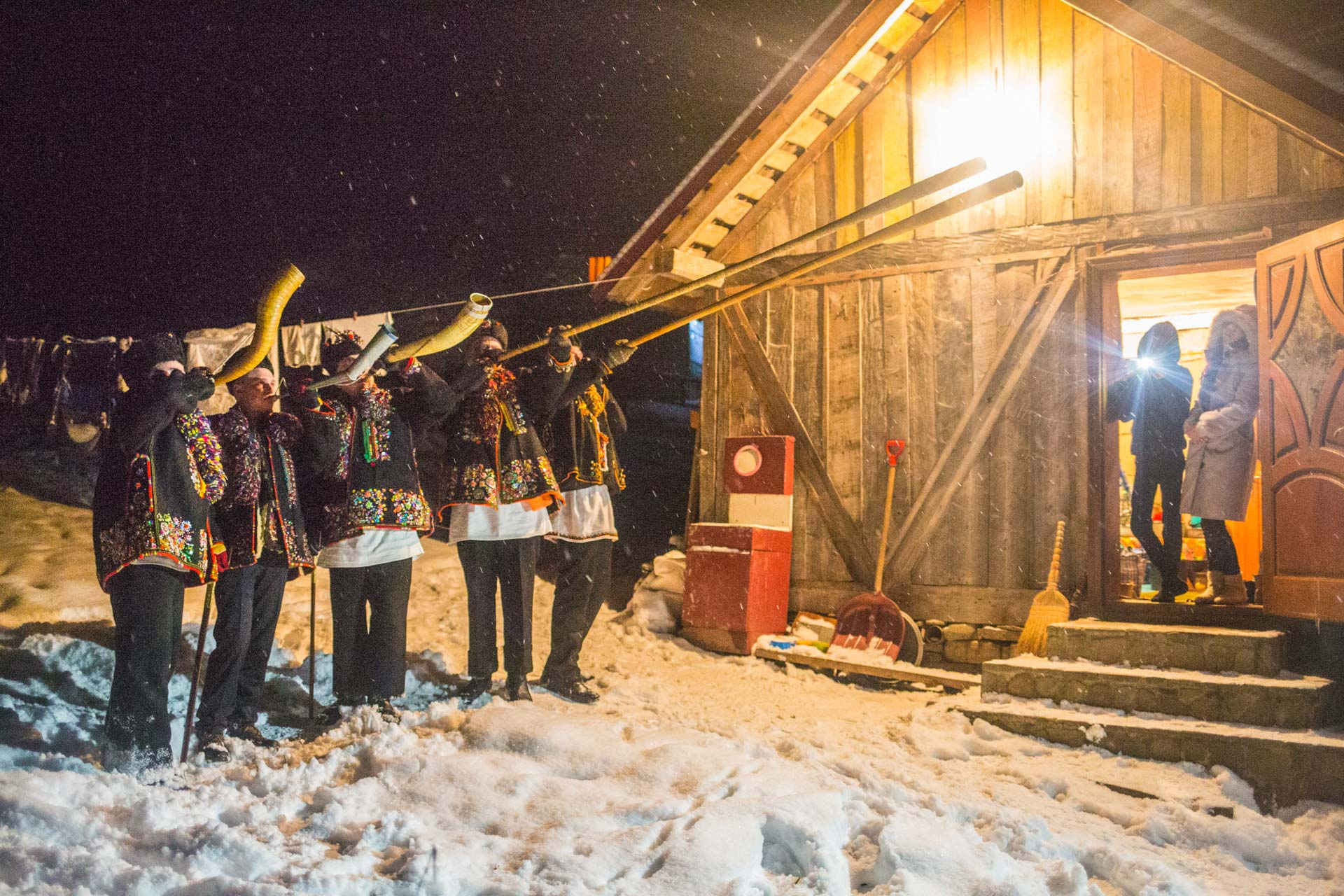
— My mother would always go for Koliada to her sister in Krasnoillia. She used to say: “I’ll go to visit my sister Mariika Shoivorovska on Christmas.” — “Why?” — “They live high in the mountains and let the carolers in.”
Koliada started being revived in the times of Perestroika (a period in the history of the Soviet Union around the 1980s — tr.). People realised that the repression system was no longer so powerful, and they started cautiously carolling openly. Ivan Zelenchuk believes that it was in the Verkhovyna region that Koliada was revived, and Kryvorivnia was the first village doing that because it has its ancient custom, and the people were only waiting for this possibility.
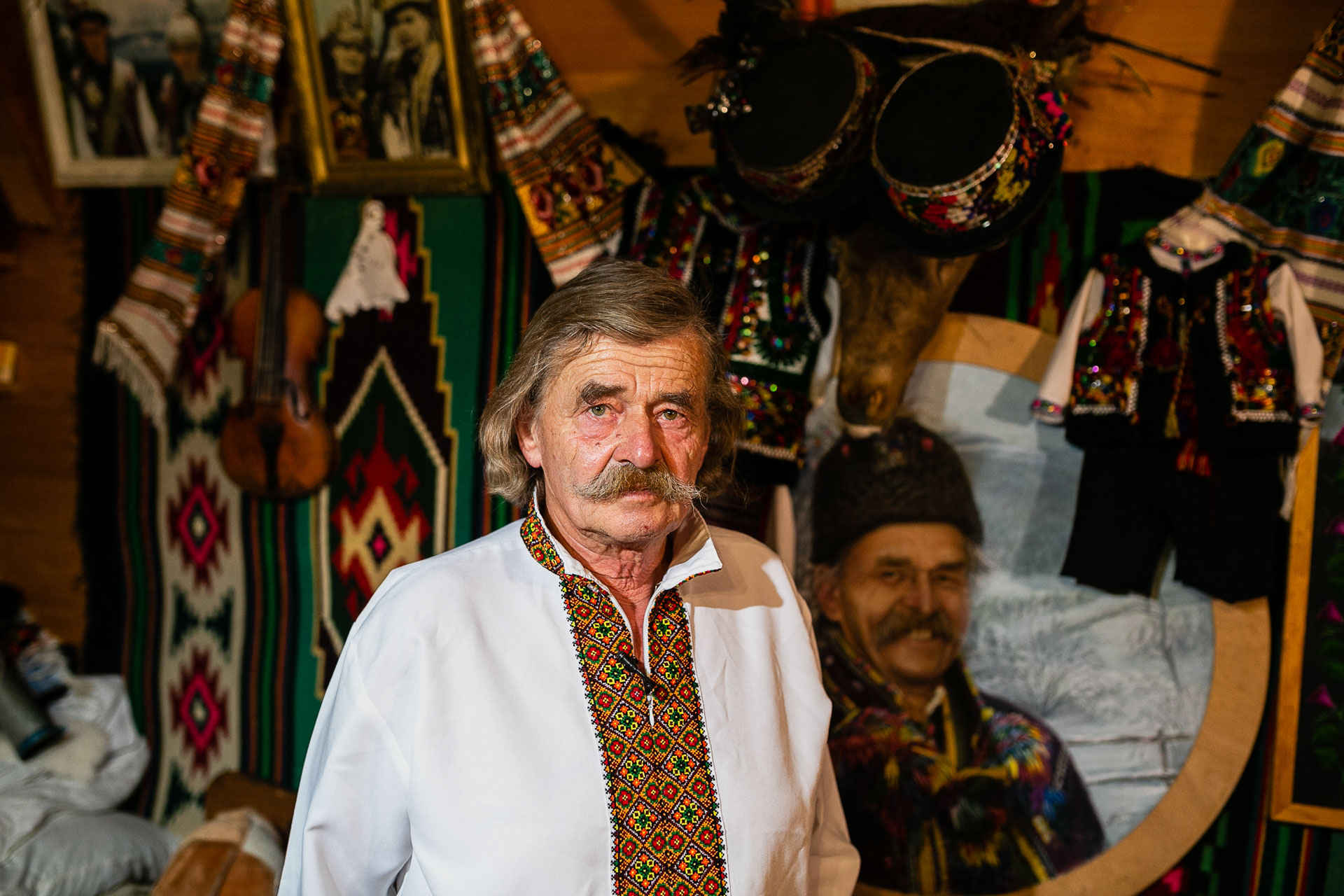
The man remembers how once the carollers came when the family were already sleeping. At that time, it was forbidden to go carolling, you could be in danger especially if you worked in public office. And there were teachers in the ethnographer’s family:
— At two in the morning, we heard somebody carolling near the house. No way! And then I went out and saw there were carolers. We opened the door and invited all the carolers inside, we laid the table with what we had. We put the treats on the table, and they were carolling — that was the first Koliada. And then they invited me to join them in carolling. I regret not going with them. I didn’t because I had a job at that time.
People say there lived an old man in the village. Not only did he know the lyrics of all carols, but he also joined a company of carollers in his old age, after an almost fifty year long break.
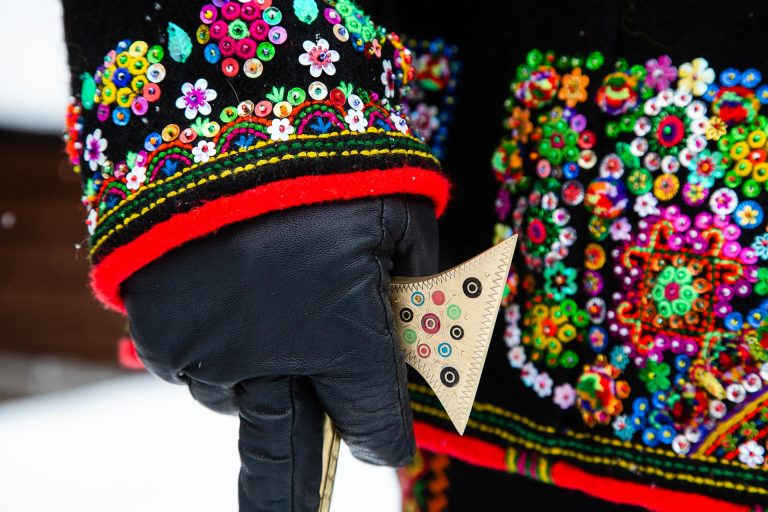
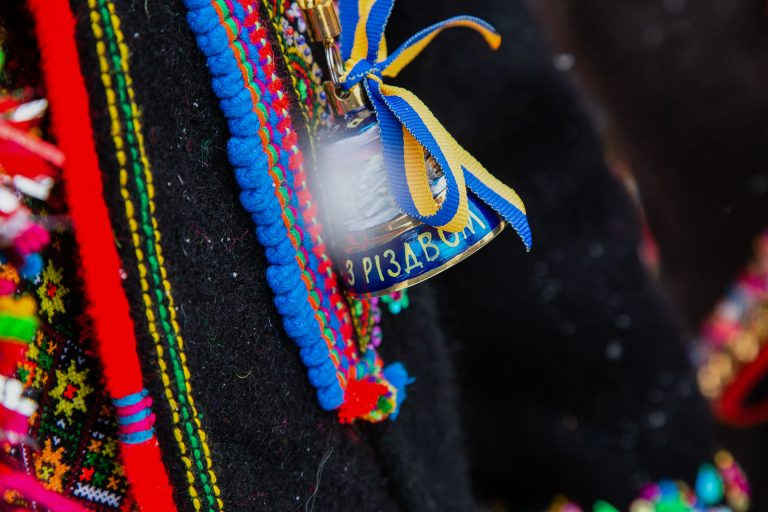
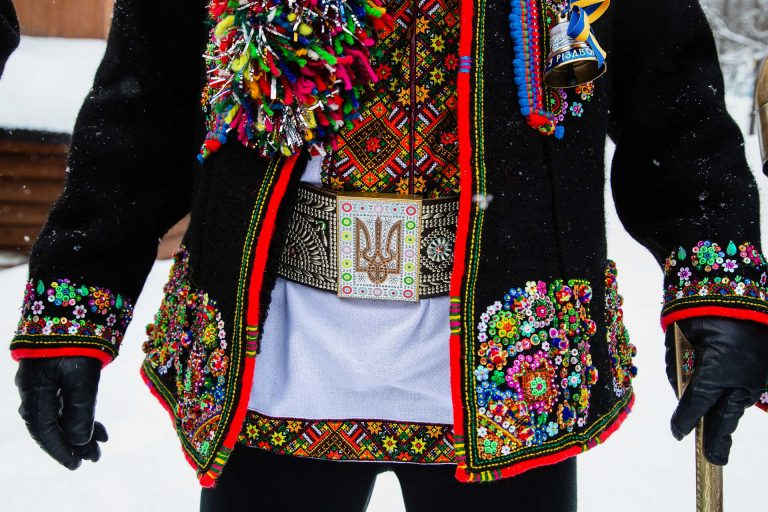
slideshow
When Koliada was revived again, even such old men, who could barely walk out of their house, went carolling together with the youth. The tradition didn’t die because people who remembered it still lived, and they didn’t have to start from scratch.
Bereza Ivan Zelenchuk remembers that in Kryvorivnia the church wasn’t closed, and here came a company of carollers from Verkhovyna because their church was burnt down:
— So, those from Verkhovyna came for plyes near our church, and some of our people from Kryvorivnia joined them too, and they came for plyes near the church almost every year. And that was something, you know, when you heard that plyes, it really hurt: there was nothing forbidden, there was nothing anti-state in those carols.
Anti-Soviet texts did exist: about the year 1947 when the locals were exiled to Siberia, there were carols about the Ukrainian Insurgent Army — those carols were banned.
When practicing religion openly was allowed, there were only one or two companies of carollers in the village, but later they formed one for each hamlet.
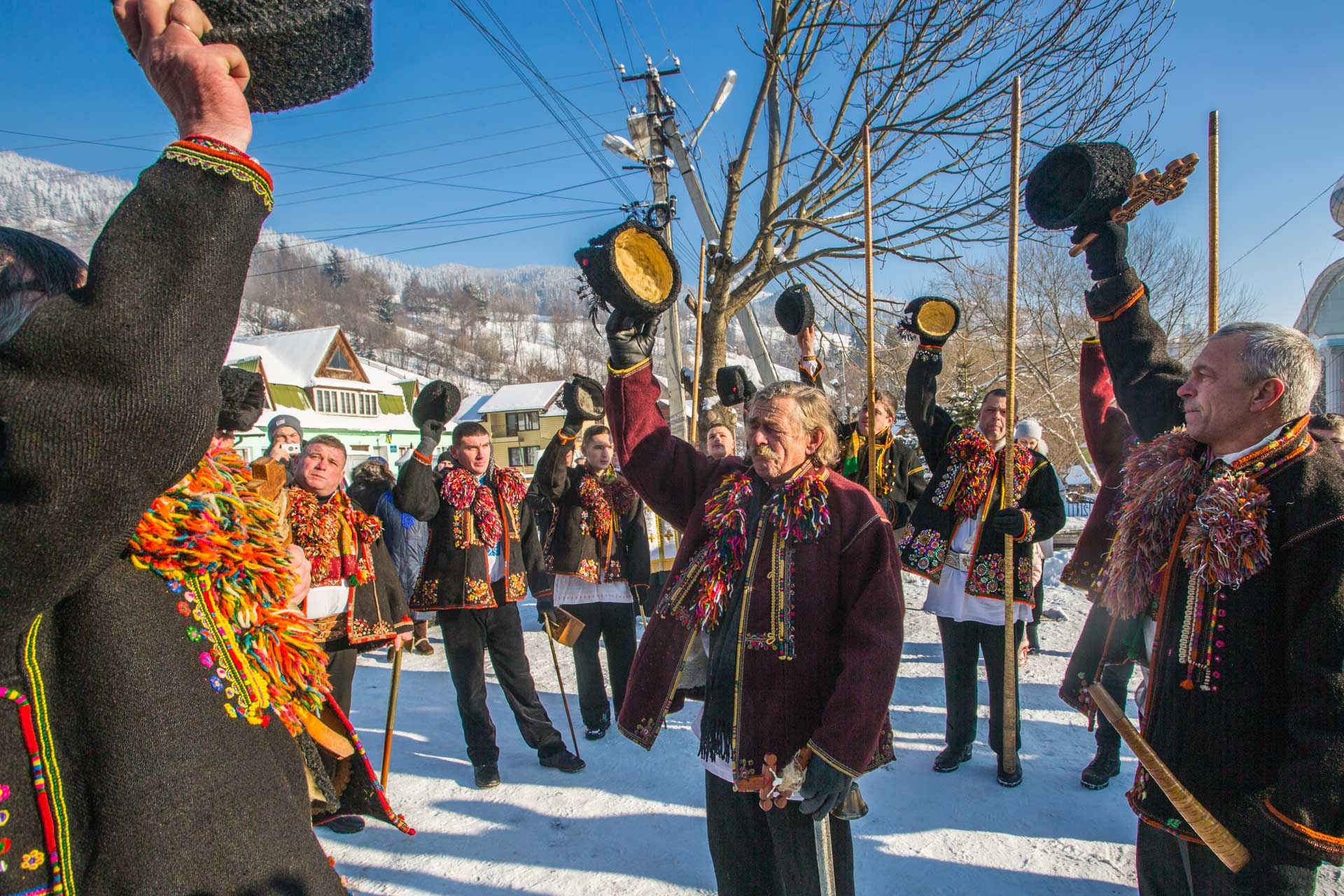
Rozkoliada
After twelve days of carolling, the company meets for Rozkoliada (end of Koliada — tr.) at their bereza’s house, they carol for him and his family. After carolling, they drink from the bell and thank him for the treat. Bereza and the fiddler stand in the middle, and the carollers dance all the plyeses they know around them. Then, bereza comes to each caroller in turns, sings to him as a sign of gratitude, and lets him kiss the cross. They all ask the Lord to let them live until the new Koliada next year:
— On Epiphany, we go to the river, there we dance the plyeses, kiss berezas and each other goodbye.
If some caroller misbehaved, they let him kiss a shovel with a girl’s face painted on it. This observance of Rozkoliada is the most touching moment because the men, who went carolling together for two weeks, are saying goodbye.
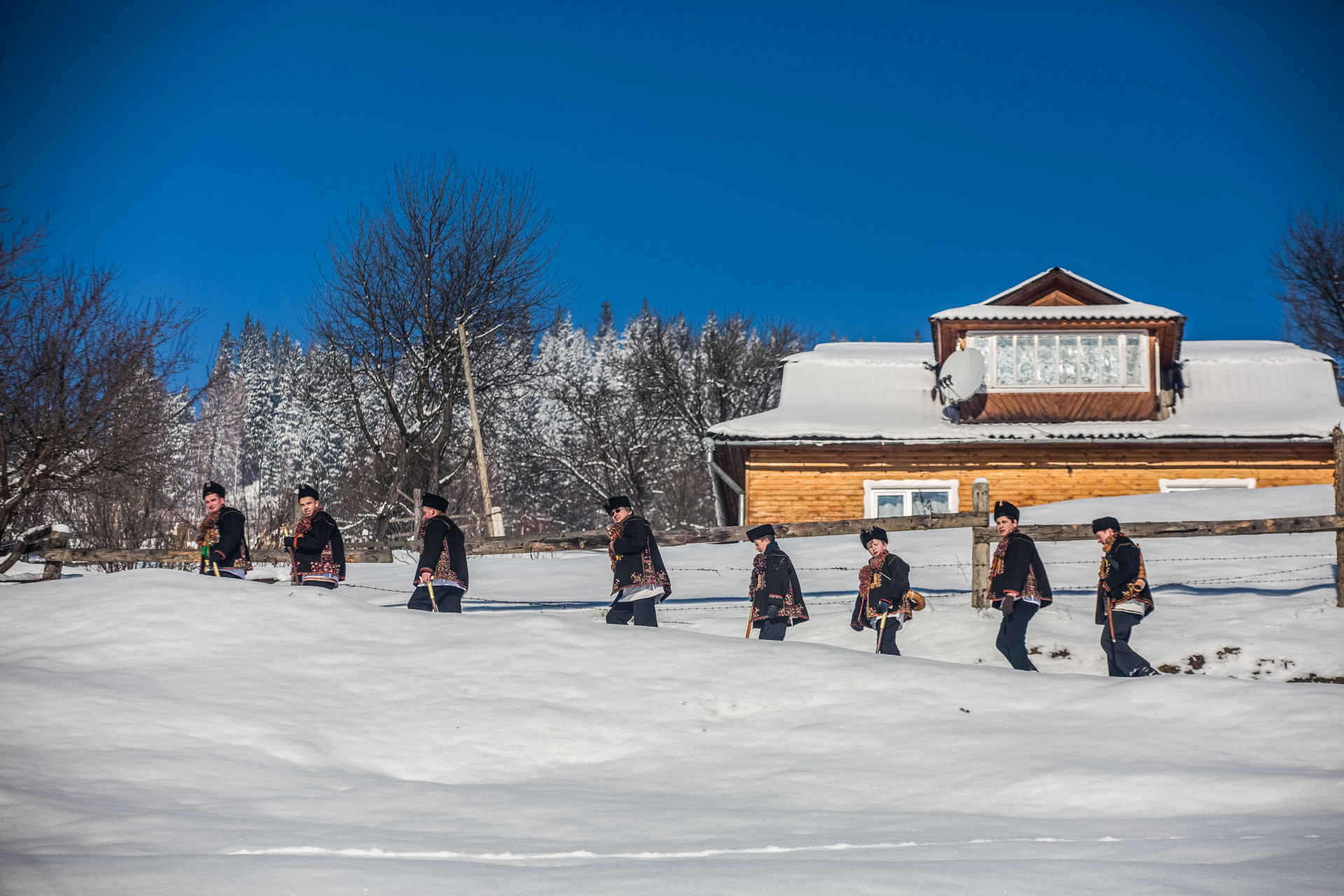
Hutsul Koliada with plyes is a unique example of an uninterrupted singing tradition in the Carpathians. This Koliada is an implementation of the Hutsul soul, a part of their genetic code. That’s why this holiday is still living and has no room for cheap tricks — people are doing this for themselves in the first place. That’s where their power is, as they know how to feel and live in the spirit of the holiday; not only sing and eat, but try to perceive the point and importance of Koliada as a possibility to rediscover the very essence of Christmas. Every year, a company of the same people meet and go carolling to the same houses. The vital part of this tradition is the togetherness in Koliada, which makes it happen. In Kryvorivnia, they say that understanding Koliada means understanding Hutsuls.

